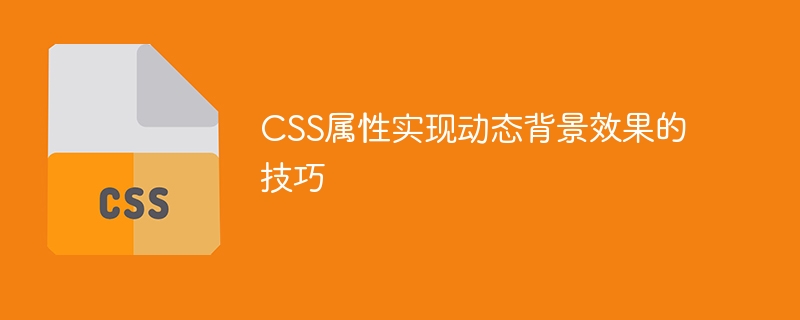

Techniques of CSS attributes to achieve dynamic background effects
Background is an important element in web design. Reasonable background design can increase the visual effect of the web page and achieve a better Good user experience. CSS provides a wealth of properties and techniques to achieve various dynamic background effects. This article will introduce some CSS properties and code examples in detail to help readers understand how to apply these techniques.
1. Gradient background
Gradient background can add a soft transition effect to the web page. We can use the background-image property and background-color property of CSS3 to achieve a gradient background.
Code example:
body {
background: linear-gradient(to right, #ff6e7f, #bfe9ff);
}In the above code, the linear-gradient() function generates a gradient background from left to right. The starting color is #ff6e7f and the ending color is # bfe9ff. By modifying the direction and color value of the gradient, different gradient effects can be achieved.
2. Background animation
Through the animation property of CSS, we can achieve dynamic effects of the background, such as the flashing of the background color, the rotation of the background image, etc.
Code example:
@keyframes backgroundAnimation {
0% {
background-color: #ff6e7f;
}
50% {
background-color: #bfe9ff;
}
100% {
background-color: #ff6e7f;
}
}
body {
animation: backgroundAnimation 3s infinite;
}In the above code, we define an animation named backgroundAnimation. In the key frames of the animation, the background color will gradient from #ff6e7f to #bfe9ff, Back to #ff6e7f. Apply this animation to the body element through the animation attribute, set the animation time to 3 seconds, and play it in an infinite loop.
3. Background image scrolling
Allowing the background image to scroll can increase the dynamics and gorgeousness of the web page. We can use the CSS background-position property and animation property combination to achieve the scrolling effect.
Code example:
body {
background-image: url("background.jpg");
background-position: 0 0;
background-repeat: repeat-x;
animation: backgroundScroll 10s linear infinite;
}
@keyframes backgroundScroll {
from {
background-position: 0 0;
}
to {
background-position: -2000px 0;
}
}In the above code, we first set a background image background.jpg, and then use the background-position property to set the initial position of the background image to (0, 0), and set the repeating mode of the background image to tiling in the horizontal direction. Then use the animation attribute to apply an animation named backgroundScroll to the body element. The animation time is 10 seconds, linear transition, and infinite loop playback. In the keyframe of the animation, we scroll the position of the background image from the initial position to (-2000px, 0).
Summary:
By rationally using CSS properties and techniques, we can achieve various dynamic background effects and add visual appeal to web pages. When using these techniques, considering compatibility issues, you can add browser prefixes or use related CSS libraries to provide better compatibility. At the same time, you should also pay attention to the background effects not being too complicated to avoid affecting the loading speed and user experience of the web page.
We hope that the CSS properties and code examples introduced in this article can help readers better master the implementation skills of dynamic background effects and increase creativity and attraction in web design.
The above is the detailed content of Tips for achieving dynamic background effects with CSS properties. For more information, please follow other related articles on the PHP Chinese website!